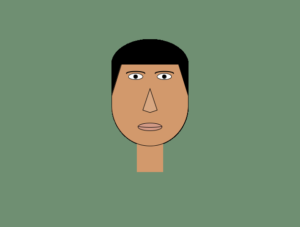For my second assignment as I was brainstorming I came across a photo of the Nokia 3310 and I remember the snake game that the phone used to have. I was reminded about how complicated the snake got as the game continued as it got longer. For the assignment I then decided to make that exact pattern but the direction and the orientation will be determined by the computer. The framecount determines when to call the change orientation and direction functions. For the orientation, when called it simply changes from x to y or vice versa. For the direction, it is determine by the modulus of a random number.
To make the line more interesting, color is added to the point. Whenever a new point is drawn it is drawn with a new color, when the change color function is called, the red, green and the blue values are changed by 1. This gives the effect of a smooth color transition.
void setup() {
size(640, 480);
}
int x = floor(random(640));
int y = floor(random(480));
int orientation = floor(random(10))%2; // 0 -> x, y -> 1
int direction = floor(random(10))%2; // 0 for up or right | 1 for down or left
//colors
int r = floor(random(255));
int rAddition = 1;
int g = floor(random(255));
int gAddition = 1;
int b = floor(random(255));
int bAddition = 1;
void draw() {
// println(x,y); // debugging code
int length = floor(random(7)); // to determine of segment
for (int i=0; i< length; i++)
{
strokeWeight(10); // make the point thicker
drawPoint(); // draw a point
updateCoordinate();
offScreenFix();
}
int nextInterval = floor(random(25, 60));
if (frameCount%nextInterval ==0) // to change the direction
{
orientation();
direction();
}
changeColor();
}
void offScreenFix() {
//if point off screen
if (y>478) {
y-=1;
println("off screen");
} else if (y<2) {
y+=1;
println("off screen");
}
if (x>638) {
x-=1;
println("off screen");
} else if (x<2) {
x+=1;
println("off screen");
}
}
void updateCoordinate() {
if (orientation == 0) {
// do x operations
if (direction == 0) x+=1;
else if (direction ==1) x-=1;
} else if (orientation == 1) {
// do y operations
if (direction == 1) y+=1;
else if (direction == 0) y-=1;
}
}
void orientation() {
if (orientation==0) orientation = 1;
else if (orientation==1) orientation = 0;
}
void direction() {
direction = floor(random(10))%2;
}
void drawPoint() {
stroke(r, g, b);
point(x, y);
}
void changeColor() {
if (r==255) {
rAddition = -1;
r += rAddition;
} else if (r==0) {
rAddition = 1;
}
if (g==255) {
gAddition = -1;
} else if (g==0) {
gAddition = 1;
}
if (b==255) {
bAddition = -1;
} else if (g==0) {
bAddition = 1;
}
r += rAddition;
g += gAddition;
b += bAddition;
}

